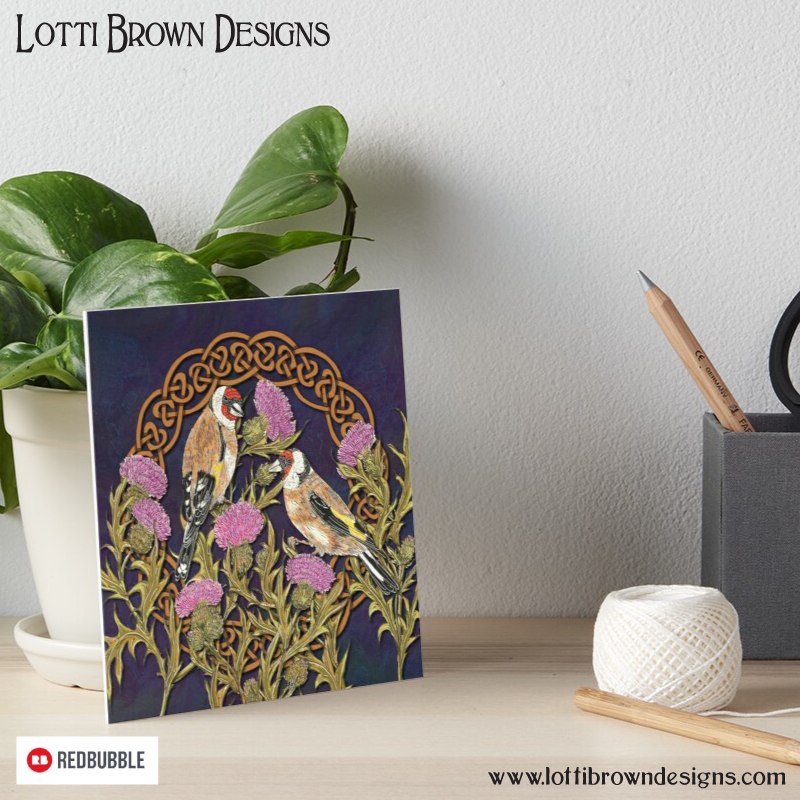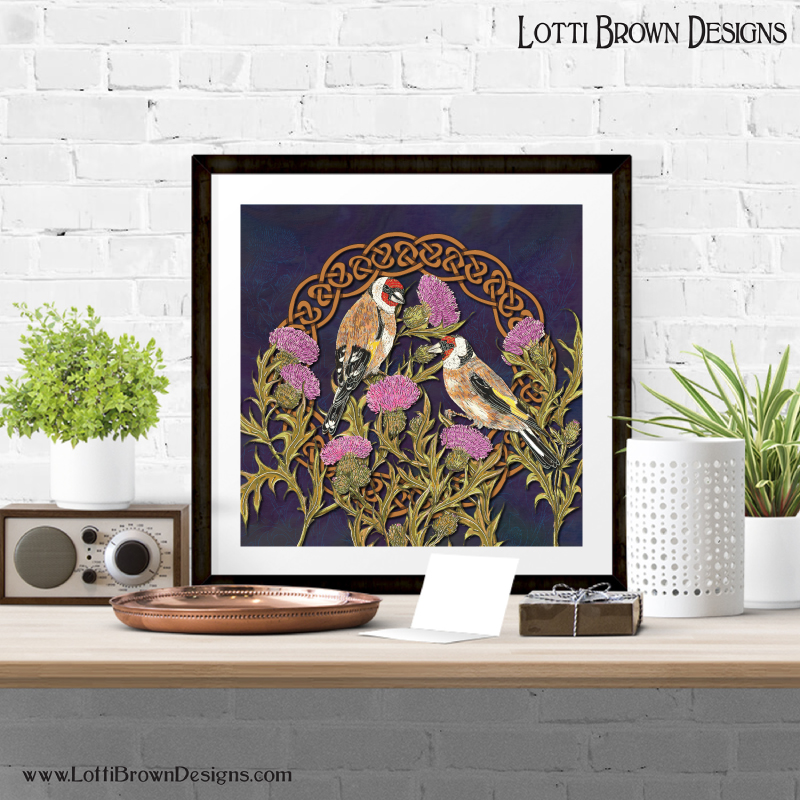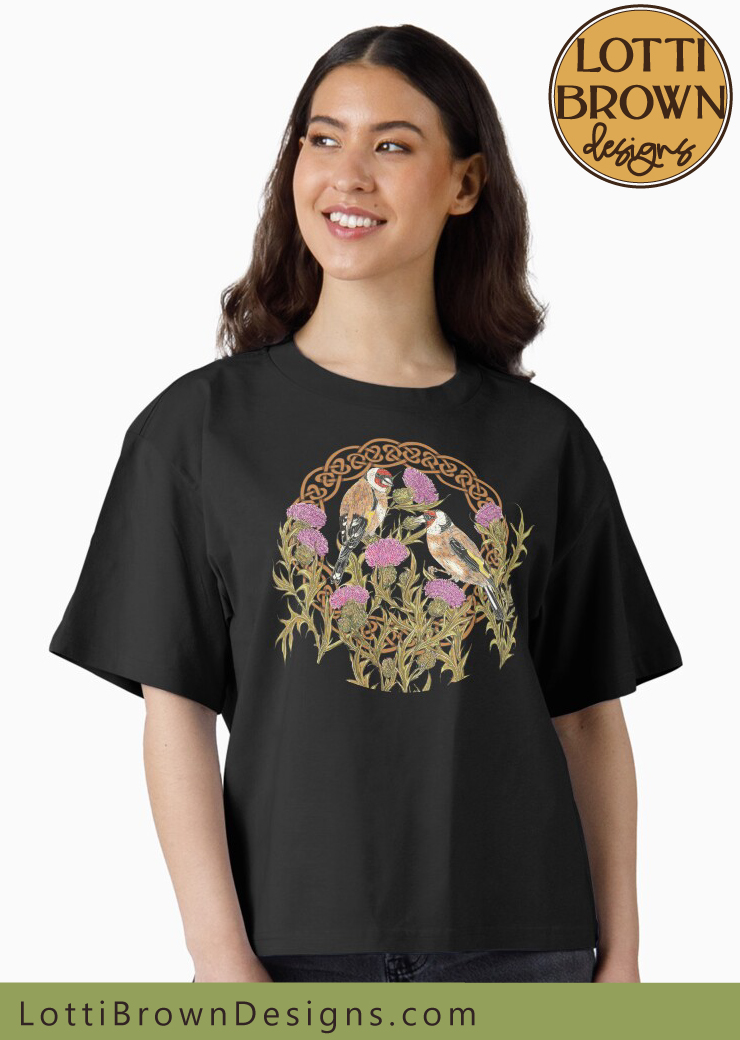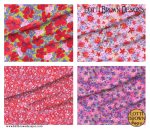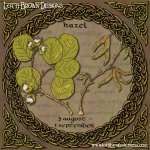AUGUST 2025 - I'm saying goodbye to the SVG part of my business. My SVG files and web pages are now in the ARCHIVES part of the site. For now, they'll still be available to purchase and the web pages with the instructions will remain available for a limited time. It's important to know, though, that my intention is for these (both files and web pages) to be removed after 31st December 2025.
IMPORTANT: please ensure that you have everything you need - files and/or instructions printed off - by 31st December 2025 as they will not be available after this date.

European Goldfinch Art
& Symbolism of the Goldfinch
- Home
- Nature Art
- Celtic Art
- Goldfinch Art
My European Goldfinch art plus a dive into the history, myth and symbolism of the goldfinch, one of our prettiest and most melodic little songbirds...
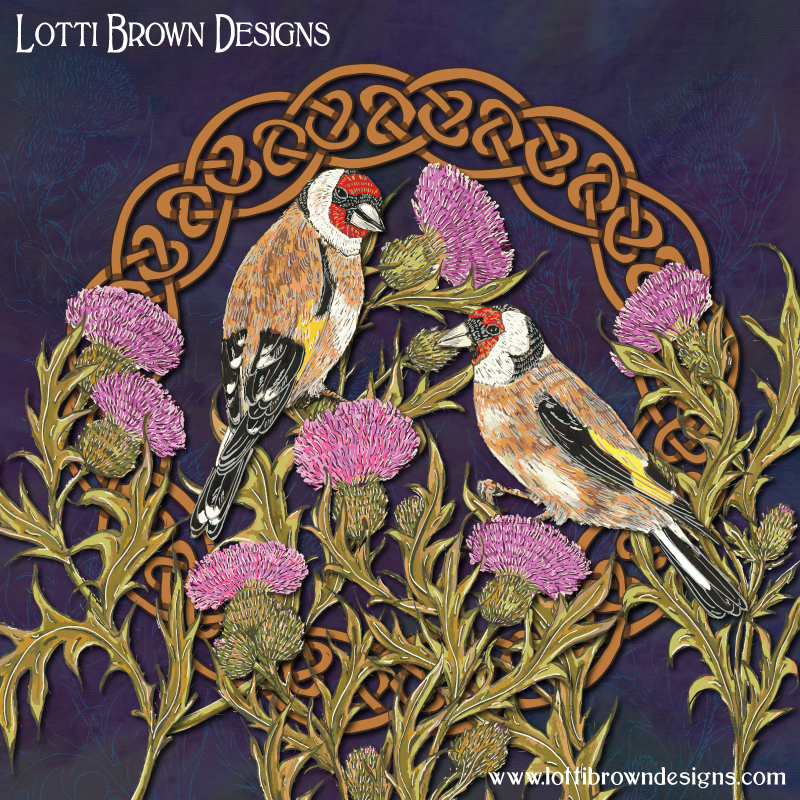 European Goldfinch artwork by Lotti Brown
European Goldfinch artwork by Lotti BrownThis page is about the European Goldfinch, Carduelis Carduelis.
I look at the history, myths and symbolism of the goldfinch, plus share my own art and pages from my nature journal as I've recently been lucky enough to have goldfinches nesting right outside my bedroom window!
History, Myths and Symbolism of the Goldfinch
One of our most beautiful and colourful wild birds, goldfinches are also a bird we have a long history with, and they feature in a fair few bits of bird folklore, too…
What's in a name..?
The Anglo-Saxon word for goldfinch was the familiar ‘goldfinc’
But it was also known as ‘Thisteltuige’ meaning ‘Thistle-tweaker’.
And in Gaelic, 'Las air-choille' meaning 'Flame of the Wood' due to its beautiful colouring!
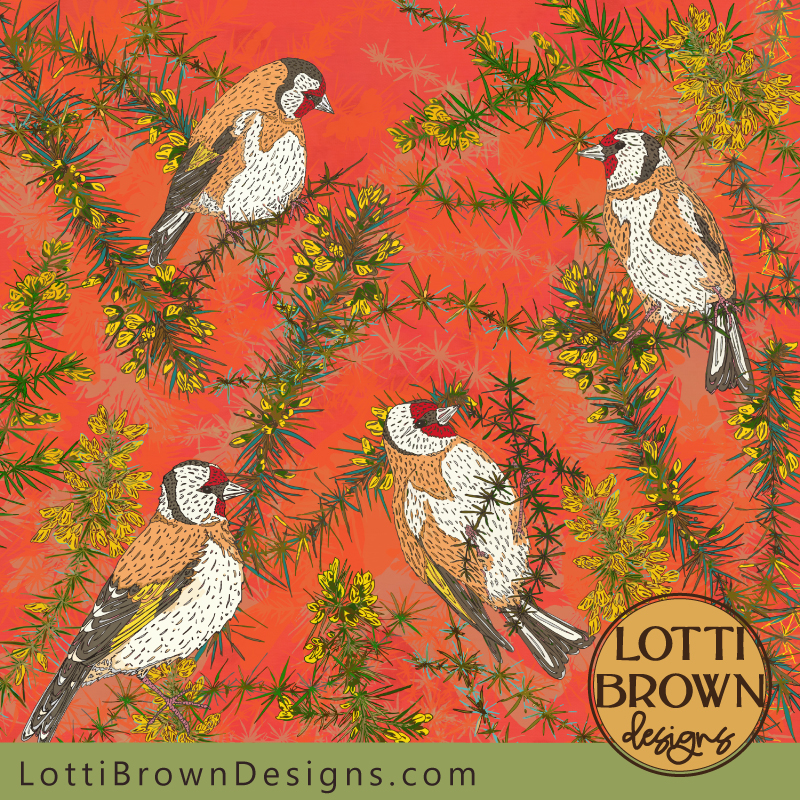 Goldfinches art in orange - by Lotti Brown
Goldfinches art in orange - by Lotti BrownClick here to browse art prints and more of this goldfinches artwork
Goldfinches love thistle seeds – one of their common names is the ‘thistle-finch’ and even the goldfinch’s Latin name is ‘Carduelis Carduelis’ which comes from the Latin word for thistle, ‘carduus’.
Other common names refer to the jaunty colour of the goldfinch – ‘goldspink’, 'goldie', ‘gold linnet’, and ‘proud tailor’ as well as 'Seven-coloured Linnet', 'Foolscoat', or 'Lady with the twelve flounces'.
The goldfinch also used to be known by the name ‘redcap’, as illustrated by a John Clare poem:
“The redcap is a painted bird
And beautiful its feathers are;
In early spring its voice is heard
While searching thistles brown and bare…”
Sometimes, 'Redcap' was 'King Harry Redcap' or just 'King Harry'.
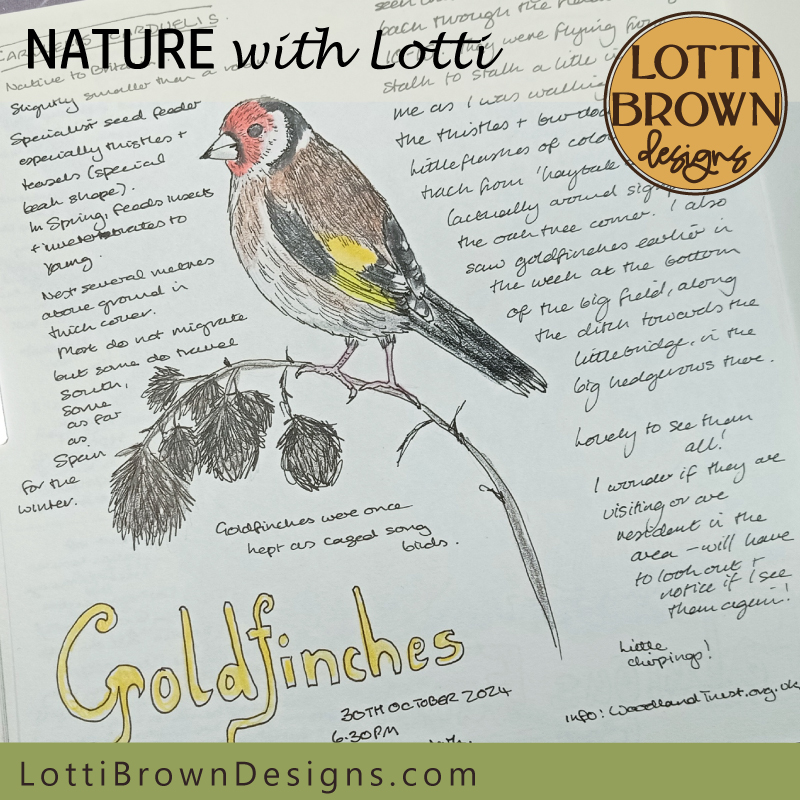
In earlier times, the gold colour of the birds’ feathers led people to associate them with gold – ie. gold coins and wealth.
In fact, from Tudor times, up until the 19th century, gold coins were sometimes colloquially called ‘goldfinches’. And a common folklore told that if a girl saw a goldfinch on St. Valentine’s Day, she would marry a wealthy man. The word ‘goldfinch’ was also used to refer to a rich man.
A Holy Bird
Goldfinches also have significant symbolism in the Christian tradition – soul, sacrifice, death, and especially resurrection and the Passion of Christ.
It’s said that the goldfinch saw Jesus’ suffering as he carried the cross to Golgotha. He flew down to pluck the thorns from the crown of thorns. In doing so, some of Jesus’ blood fell upon his face.
As well as accounting for the red face of the goldfinch, this also takes note of the reason for the goldfinch’s love of eating the seeds of prickly plants like the thistle and teasel.
Many Renaissance artworks show a goldfinch alongside the Madonna and Child, where the goldfinch is a symbol of the Resurrection – for example, The ‘Madonna Litta’ (1490-91) by Leonardo da Vinci, and the ‘Solly Madonna’ (1502) and ‘Madonna of the Goldfinch’ (1506) by Raphael.
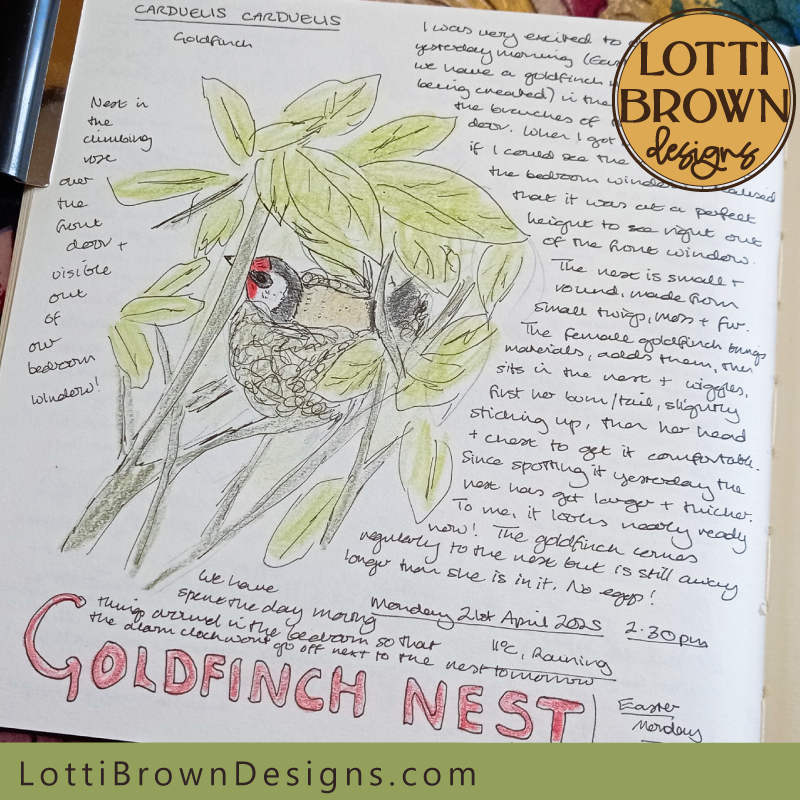 Goldfinch building a nest outside my window - page from my nature journal
Goldfinch building a nest outside my window - page from my nature journalA Healing Bird
In Renaissance times, the goldfinch also had a reputation for healing sickness.
Leonardo da Vinci wrote about a goldfinch being brought to a sick man. If the goldfinch turned away, it was believed that the unfortunate gentleman would die, but if the bird continued to look at the patient, then the goldfinch would himself cure all his sickness.
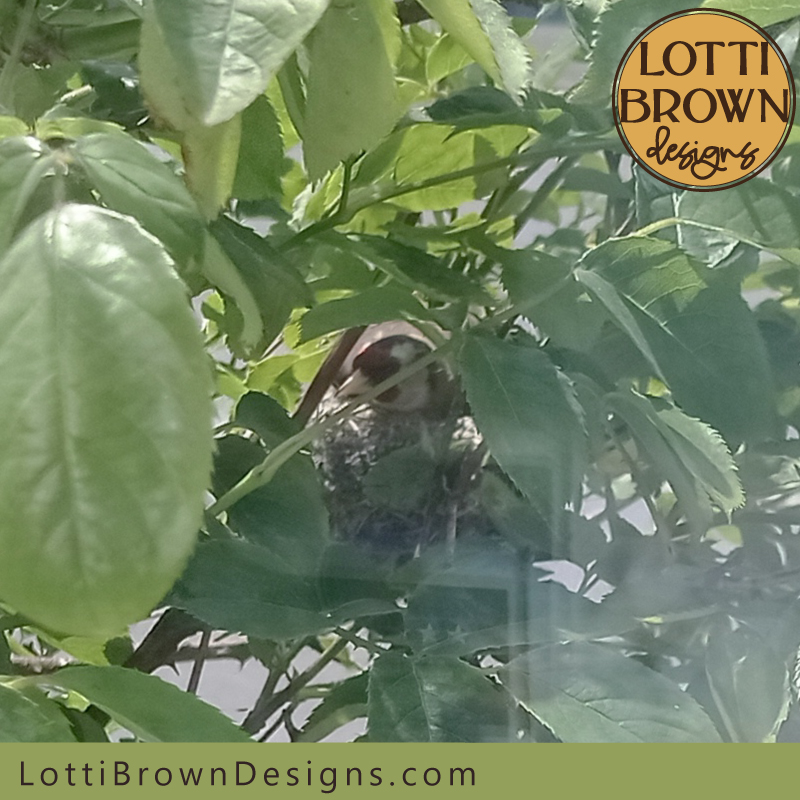 Goldfinch nesting just outside my bedroom window
Goldfinch nesting just outside my bedroom windowA Bird of Beautiful Song
Goldfinches are also known for their very beautiful song. The collective noun for a goldfinch is a ‘charm’, believed to derive from the Middle English ‘c’irm’ (‘chirme’ or ‘charme’) meaning a clamour of songs or the Latin ‘carmen’ meaning a magic song or spell.
By the Victorian times, goldfinches were kept as caged birds for their song – they were bred extensively and taught tricks. But it was a cruel practice, involving the birds being trapped, sometimes caught on branches by super-sticky ‘bird lime’ – and some were even blinded by hot needles, which was thought to remove visual distractions from the bird to provide the owner with continuous singing. A cruel and barbaric practice!
One of the first campaigns of the emerging Society for the Protection of Birds (now the RSPB) was ‘Save the Goldfinch’, which, happily, was a success, so that we can now enjoy these beautiful birds wild in our hedgerows and gardens, free, as they should be.
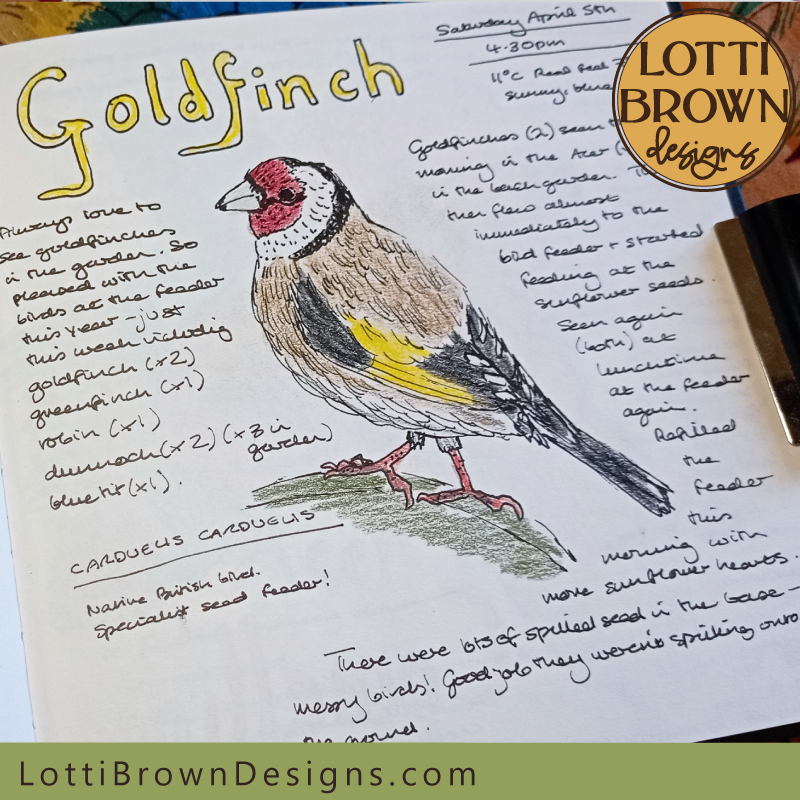 Goldfinch in my nature journal
Goldfinch in my nature journalSymbolism of the Thistle
As we've already seen by the name, the goldfinch is very strongly associated with the thistle and will often take on some of the qualities of the thistle by association.
As well as its association with the goldfinch, the thistle has its own symbolism, folklore, and meaning. The most well-known is its representation of courage, strength, and determination as the emblem of Scotland.
It’s said that this is connected to the legend of an attack by vicious Norsemen on Largs in Scotland. They were attempting a night-time invasion whilst the Scottish Clansmen slept. The Norsemen were prickled by thistles and called out, so warning the Clansmen of the attack. The thistle became the emblem of Scotland, along with the motto ‘Nemo me impune lacessit’ meaning ‘None touches me unharmed’.
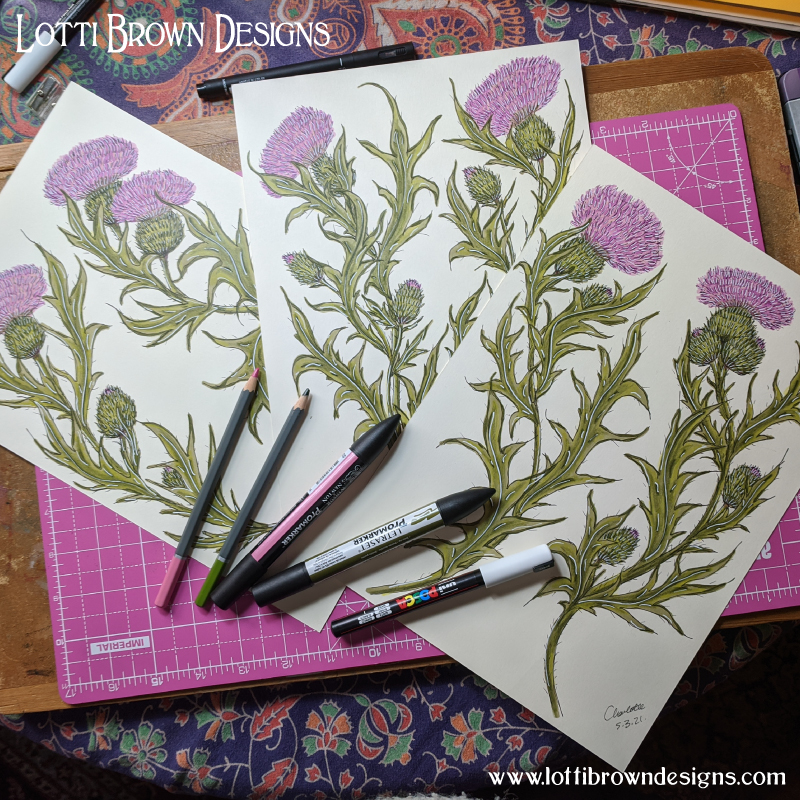 My thistle drawings
My thistle drawingsThe thistle is also said to have been of assistance to Charlemagne’s army – the army was saved from a pestilence after Charlemagne was guided by an angel to find a miraculous cure in the carline thistle.
The thistle was popular in France, Germany, and Spain, where it was often nailed to doors to forecast the weather – the thistle flower closes as rain approaches.
In the Christian tradition, the thistle is linked to the Virgin Mary. It’s said Mary used a thistle leaf to drink milk from a cow when she was thirsty. The plant became known as ‘Our Lady’s Thistle’ (also known as ‘Holy Thistle’ or ‘Blessed Thistle’) and the leaves still carry the stain from the milk.
‘Blessed Thistle’ was also believed to be spiritually purifying – it was worn to protect from evil and used in purification baths.
Ancient Chinese herbalists believed the thistle brought long life and and used it to fortify the body.
In herbal medicine, the milk thistle is still used to stimulate and balance liver function – bodily purification.
The thistle symbolises protection from harm, but its colourful flowers also represent radiant sunlight and beauty just the same as the colours of the goldfinch do.
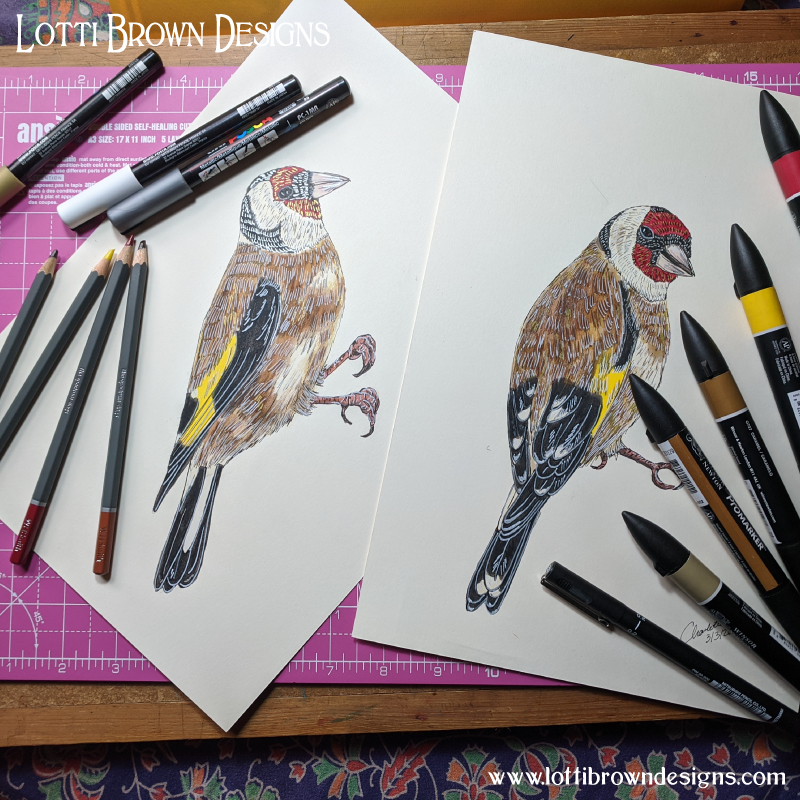 My goldfinch drawings
My goldfinch drawingsGoldfinch Meaning & Symbolism
So the goldfinch's colour symbolises beauty, light and sunshine, like shimmering gold - it also symbolises wealth or prosperity.
The goldfinch represents healing, life, resurrection and the soul.
Beauty in physical aspect as well as nature through its beautiful song expressing love and joy.
Goldfinches have also been associated with good luck and protection.
My Goldfinch Art
I created my goldfinch art from my thistle and goldfinch drawings above, plus my own drawings of Celtic knotwork circles.
I scanned my drawings into the computer and used Adobe Illustrator to put them all together into an artwork...
 Celtic Goldfinches and Thistles artwork by Lotti Brown
Celtic Goldfinches and Thistles artwork by Lotti BrownIf you like my goldfinch art, you can get it as art prints (various sizes, framed or unframed) plus home decor, fashion, and accessories.
Here are just a few ideas to inspire you - there's also shower curtains, mugs, sweatshirts, phone cases, laptop cases, bags, pouches, notebooks, stickers, badges, and more...
You can get all the above from my Redbubble store with worldwide delivery from your nearest manufacturing location, plus customs charges refunded if you do happen to be charged.
You Might Also Like
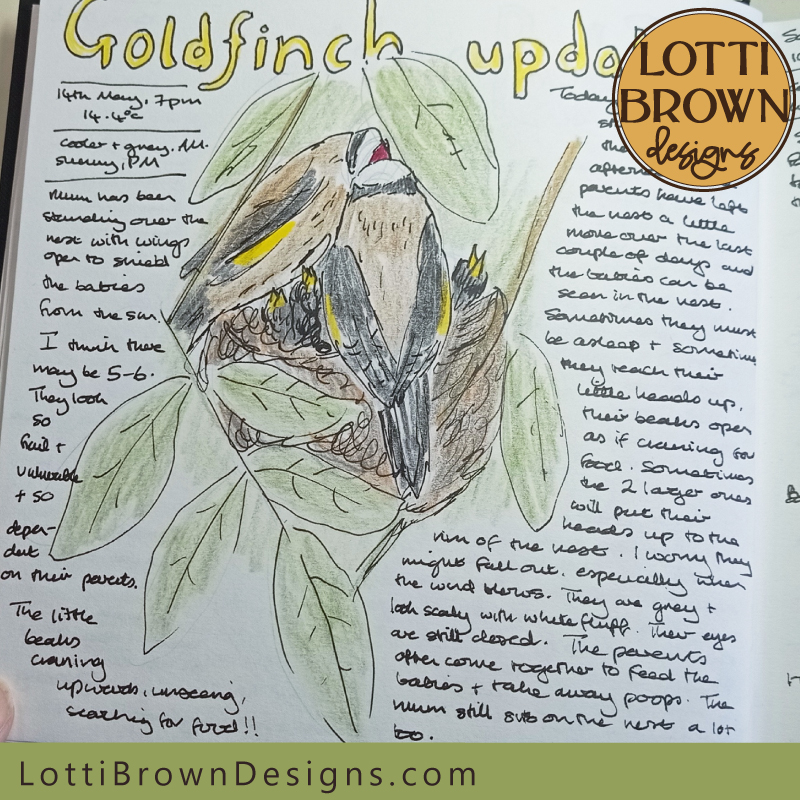 Nesting goldfinches diary in my nature journal
Nesting goldfinches diary in my nature journalIf you like goldfinches, you might like to follow my nesting goldfinches diary in my nature journal - sharing what I saw when goldfinches nested right outside my bedroom window - read all about it here!
I also have a further European goldfinches artwork, that you might also like...
You can also explore all my bird art here, plus I also have many birds in my Celtic art section here...
Explore nature journaling here!
I also have some nice bird book recommendations you might enjoy - this about bird language - and these about robins!
Further Reading
- A History of Birds – book by Simon Wills
- The Folk lore and provincial names of British birds - book by Charles Swainson
- Discovering the Folklore of Plants – book by Margaret Baker
- Penguin Dictionary of Symbols
- https://animalsmattertogod.com/2012/06/03/goldfinch-symbol-for-resurrection/
- https://nelliecole.com/2020/07/10/folkdays-goldfinches/
- https://mountainroseherbs.com/blessed-thistle
Want to keep in touch?
Sign up below for my free email newsletter...
My newsletter is usually sent out once a month (at the end of one month or the start of the following month) and you can unsubscribe any time...
Sign up below...!
Recent Articles
-
Poppy Print Fabric, Wallpaper & More
Aug 13, 25 06:20 AM
Gorgeous red poppy print fabric, wallpaper, homewares and accessories, created by artist-designer Lotti Brown... -
Big Changes for SVG Files
Aug 06, 25 06:11 AM
I've been creating SVG files since 2021, and it's something I've loved to do and to share. The world has changed a lot in these few years, though, and it's now time for me to say goodbye to that part… -
Hazel Tree Symbolism and Celtic Hazel Art
Aug 05, 25 05:12 AM
Learn about hazel tree symbolism, myths and meanings as I share my Celtic Tree Calendar hazel art...
Follow me:
Share this page:

